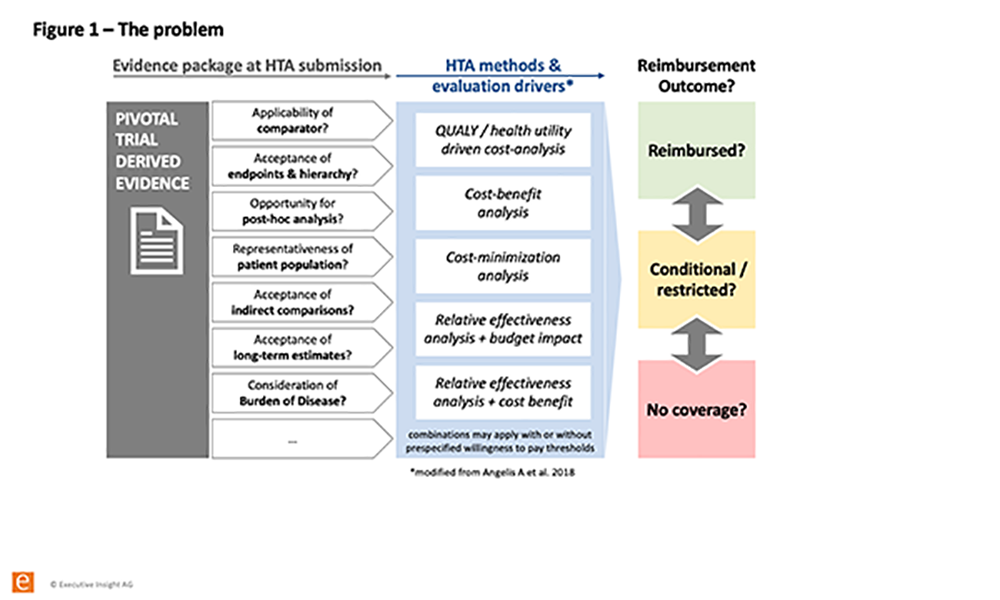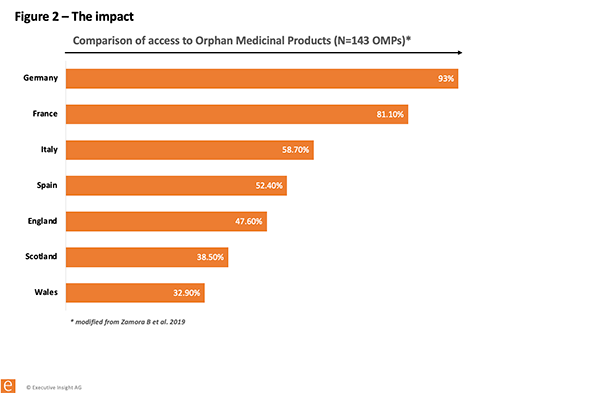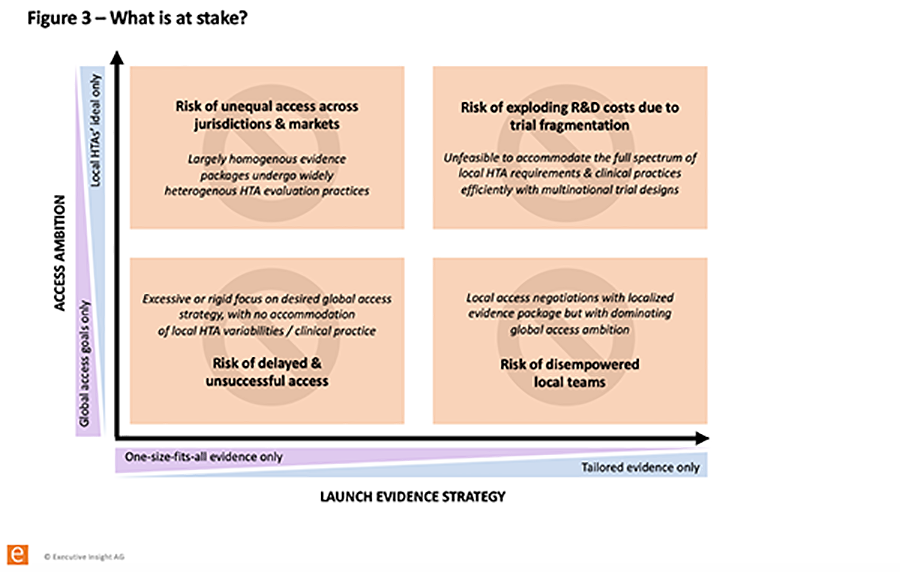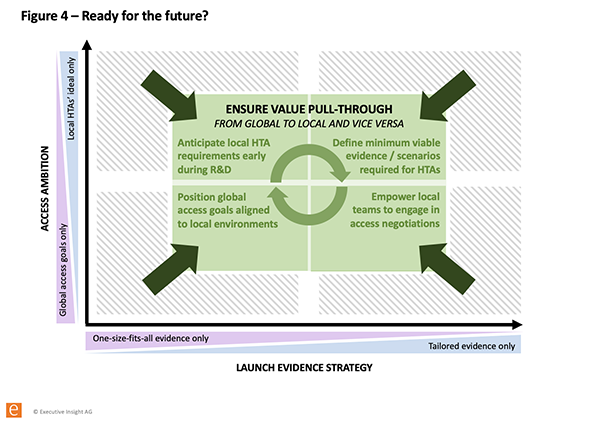- Sustainability
- DE&I
- Pandemic
- Finance
- Legal
- Technology
- Regulatory
- Global
- Pricing
- Strategy
- R&D/Clinical Trials
- Opinion
- Executive Roundtable
- Sales & Marketing
- Executive Profiles
- Leadership
- Market Access
- Patient Engagement
- Supply Chain
- Industry Trends
How a “Push and Pull” Approach Can Maximize Innovation Value through HTAs
When global pharma teams support local submissions for Health Technology Assessment (HTA) bodies it may feel sometimes as though they are trying to fit a square peg into a round hole. But given the huge variability between HTAs in each country, it’s perhaps more like trying to fit a square peg into a whole range of differently shaped holes.
HTAs across countries are so heterogenous because each one provides recommendations based on their regional or national preferences, shaped on societal and cultural values.1 That’s understandable, but it leaves companies having to adapt their single evidence package at launch into multiple, tailored versions, which is not only extremely time and resource consuming but can still lead to a highly heterogenous reimbursement landscape across markets especially if local HTA variances are not considered early on.
At the heart of this topic is the concept of value. Every HTA in the world is seeking to achieve the best value for their healthcare system. But the way how value is defined, how evidence is included and evaluated and the procedures, processes and legal frameworks that apply, differ considerably (Figure 1).2
Click to enlarge.

For example, in England/Wales and Scotland, most recommendations include cost effectiveness assessments and price negotiations. In the Netherlands, some HTA recommendations include cost-effectiveness evaluations while they are completely absent in Germany. There is increasing level of awareness across jurisdictions that value definition requires a multi-dimensional approach that is not limited to clinical benefit and cost alone but the selection of value drivers, their relative importance and how to translate them into monetary value varies across countries.3
Unsurprisingly, the significant variability between different country HTAs can result in significant variability in terms of outcomes and timings. A recent EFPIA study revealed that patients in certain countries can wait considerably longer for access to new medicines compared to others, with median times from EMA marketing authorization to date of patient availability varying from 53 days in Germany to 352 days in Spain, to a staggering 749 days in Poland (EFPIA Patients W.A.I.T. Indicator 2019 Survey).
Even orphan medicinal products — with undoubtedly highest and homogenous cross-country unmet need — have been shown to be associated with significantly different rates of access per country, with France and Germany reimbursing more than 80%, Italy 59%, Spain 52% and England, Scotland and Wales less than 50% of products (Figure 2).4

So, we know that “one-size fits all” is not workable. But we also know that generating evidence on an entirely individual national level is not feasible. So, what’s the best solution?
The foundation: engaging early
“Engage early with HTAs” should be one of the key mantras for pharma in upcoming years. Companies are increasingly working with EUnetHTA’s framework, which enables early dialogues between multiple HTA bodies and companies.
It’s a mantra that will become increasingly important in a rapidly changing environment. Budgets are under pressure due to COVID-19, with sources of healthcare systems funding (e.g. direct employee contributions and taxes) all significantly impacted, and a severe backlog of surgeries and other treatments likely to trigger budget spending peaks in the near future.
Therefore, if anything, HTAs are likely to drive even more restrictive assessments in order to manage shrinking budgets which further limits any remaining room for clinical uncertainty and evidence gaps. Also, countries themselves may “join forces” more in the future to increase their bargaining power especially for extremely high cost therapies. This was seen recently with Zolgensma (onasemnogene abeparvovec) for Spinal Muscular Atrophy (SMA), where Belgium, Ireland and the Netherlands have collaboratively completed the clinical and cost effectiveness assessment.5
Due to these complexities, it is even more important not to approach HTA as a hurdle to overcome later, but as something to work with at an early stage — ideally ahead of pivotal trial design.
But the challenge still remains — companies cannot accommodate the full spectrum of HTA requirements within feasible R&D timelines and investments. Trying to do so would likely lead to trial fragmentation that again make statistical powering of outcomes challenging and lead to exploding development costs and associated risks. No matter where companies are plotted on the graph in Figure 3 depending on their access ambitions and launch evidence strategy, there are risks. So, how can we mitigate against these?
Click to enlarge.

“Value Push and Pull”: a two-pronged approach
A two-pronged approach to maximizing value may be optimal — pushing the design of value generation through HTAs at an early stage via joint value definition and then later pulling the value through via your local teams to ensure that value is realized at launch.
1. Pushing designs of value generation through HTAs at an early stage via joint value definition
The first element is agreeing what “value” means in the context of your product and pushing this through with some of the HTAs in key markets. By agreeing together on that value definition, the “pull through” of that value after launch is more likely.
While this process can take time and resources at an early stage of the lifecycle, the benefits at launch of having followed such a process, if planned correctly, can lead to more favorable long-term access scenarios that drive years of sales (the correlation of increased long-term utilization with more positive HTA outcomes is well established6) which easily outweigh upfront investments. Hence, the integration of HTA logic into early business forecast scenarios is important to clearly define and quantify business opportunities lost due to sub-optimal evidence generation at launch.
While it is unrealistic to tailor your clinical program to the needs of every single HTA, there will be common ground in your value definitions, which will help you to build or refine your clinical program. Key elements may include:
Endpoints: hard vs. surrogate
Of course, HTAs prefer incontrovertible evidence. But that isn’t always possible. For example, a randomized clinical trial for an early obesity intervention may have to run for 20 years to directly demonstrate reductions in myocardial infarction rates. That’s unrealistic.
Therefore, surrogate measures are sometimes the only way of assessing early benefits in such patients in a controlled way. Identifying these early with HTAs and showing their link to your product’s value is key as they are often the foundation of clinical trial programs. It’s important that you can demonstrate that your chosen surrogates have a valid relationship with hard endpoints (i.e. demonstrated repeatedly in high quality epidemiology studies and both ways through positive as well as clear negative correlations).
Additionally, it may be worth focusing on a heterogenous study population consisting of both early and mediate stages of disease that were predefined in the clinical protocol. The latter population may be able to drive a hard endpoint, at least in secondary configuration and may ultimately be used as a fallback with HTAs.
Endpoints: single vs. composite
Composite endpoints are endpoints that are composed of multiple clinical dimensions. They can be tempting to utilize because the benefits include increased statistical efficiency, decrease in sample-size requirements, shorter trial duration, and decreased cost.
Often, composite endpoint designs are also clinically justified (e.g., in certain oncological indications “partial response” is defined as entailing several clinical parameters that need to be favorably affected by an intervention but in different combinations or magnitudes7).
However, during HTAs this may pose the complexity for authorities to clearly associate incremental benefits for each outcome since they are “blurred” within the umbrella of the composite endpoint, often being not statistically identifiable.
To ensure that such evidence is assessed in a favorable way, it is important that companies show the patient relevance e.g. Quality of Life (QoL) gains of the partial response cohort vs. baseline and are prepared for being asked to “isolate” the individual components in their submission dossiers.
Showing patient and healthcare system relevance
On top of clinical parameters, HTAs often require the assessment of dedicated Health-related Quality of Life (HrQoL) metrics and for the manufacturer to measure in which way healthcare resource utilization may be affected by an intervention studied.
The respective HrQoL tools used need to be aligned with local societal health utilities that define what “good” looks like e.g. SF-36 health survey assessed QoL may pose an issue in non-Western cultures due to differing weight of physical vs. mental components.8
All of these aspects challenge the manufacturer to think and act a bit differently to how they have traditionally. But it is also fair to ask the same of the HTAs. Are they really ready for innovation? Are they open-minded to alternative ways to demonstrate value?
For example, local standards of care often differ to the ones used as a standardized comparator in RCTs.
While HTAs understandably would prefer data entirely relevant to their market, the individualization of trials to all existing local practices is not feasible, so flexibility is needed on their side too. This is especially true in rare diseases, where use of a single arm study or indirect outcome comparisons to historic controls may be the only way to bring new treatments to patients who desperately need them.
The same is true for retrospectively defined sub-populations. Yes, it may create a bias, but it will never be possible to fully predict a-priori which patient type may respond best in a RCT. To deny research to fully leverage its learnings, also when unexpectedly acquired, means to deny facts that were developed in a robust, potentially double-blinded and controlled regimen. Gaining agreement on these sorts of potential outcome early on could have huge benefits further along the road.
2. Pulling value through post-launch via local teams
The second part of the two-pronged approach involves using your local teams to help pull through the value at time of launch and maintain brand value in the long-term.
It is critical to ensure clear and consistent value communication and HTA associated access negotiation guidance across all affiliates and geographies. In order to build on communalities whenever possible but to also allow for consideration of local clinical practice and differences in care-pathways, pharma companies should strive to find the middle-ground between globally guided access and negotiation strategies vs. tailored value positioning and argumentation that is aligned with local HTAs and access environments.
The value ‘pull-through’ around launch would ideally follow a clearly defined approach:
Empower local brand teams to “pull-through”
It is vital to listen to local brand teams and let them share key insights about local HTAs and anticipated assessment outcomes considering concrete phase III trial data perception in light of local care-pathway specificities. This allows further shaping of the global access and negotiation strategy which should then be aligned, and pressure tested with external country experts.
This will empower local teams to carve out an “access playing field” that clearly articulates an overall access ambition and distinct fallback positions while continuously integrating best available clinical evidence along the way - all in preparation of building their own local access strategy also for example in new, less well-known indications.
Understand local access barriers to maximize & maintain value being “pulled-through”
Secondly, the global organization must understand the needs and access barriers of local teams early on, and therefore be able to make informed scenario-based decisions when planning evidence generation investments beyond the pivotal trial program.
It is important to assess the impact of post-launch global evidence generation strategies on multiple dimensions and timelines e.g. the immediate impact of this evidence on the product itself and the remaining clinical unmet need, the mediate impact on the portfolio regarding follow-up launches or indication extensions and finally the long-term competitive landscape evolution and potential changes to standard of care or expected clinical value delivered.
Such a “value-pull-through” approach would equip local brand teams to enable value recognition by payers and HTAs, securing access at the right win-win conditions, hence maximizing the use of global pivotal trial evidence and value communication tools by truly delivering clinical gains to the right patient population. Ultimately the global organization would also be able to pave the way for innovation when building on the learnings of in-market products and insights of experts, hence ensuring that trial design / R&D costs are aligned with the common view of HTA defined value across key markets and initial access success is maintained in the long-term through meaningful investments in follow-up initiatives (Figure 4).

Conclusion
Ultimately, early and consistent focus on value in partnership with HTAs can only be good for all stakeholders, including most importantly, the patient. An open reflection internally on “sunken” business opportunities when failing to deliver the right evidence at launch may even lead to more ambitious trial designs, such as head-to-head trials vs the standard of care, which would ultimately be the basis for greater proof of innovation.
Also, the last two years have shown we live in an unpredictable environment, and this is only likely to increase the desire for conditional reimbursements and risk-sharing agreements, which necessitate mutual understanding and agreement on value definitions and evidence generation.
Whatever the future brings, by anticipating local HTA and customer requirements early on and by engaging openly with local teams and experts, including them when building evidence generation plans and training them in how to best define access scenarios, pharma companies open a window of opportunity to empower their whole organization in achieving best-possible access — in alignment with globally guided strategy but tailored to local customer needs, within consistent, pre-defined parameters.
Planning for these local access opportunities and negotiations requires more than the typical top-down approach to access strategy and value communication, putting more emphasis on engaging with and more importantly listening to key stakeholders genuinely, both outside and inside pharma organizations, and acting on these insights. With this mindset in place, companies will be well placed to maximize the value of their innovations through HTAs.
Alexander Kriz and Lisa Sigl are Directors, Cristiana Toader is Manager, and Lea Bucher is Principal, all at Executive Insight.
References
1. Rick A. Vreman, Aukje K. Mantel-Teeuwisse, Anke M. Hövels, Hubert G.M. Leufkens, Wim G. Goettsch. “Differences in Health Technology Assessment Recommendations Among European Jurisdictions: The Role of Practice Variations.” Value Health. 2020; 23(1):10–16.
2. Angelis A., Lange A. and Kanavos P. “Using health technology assessment to assess the value of new medicines: results of a systematic review and expert consultation across eight European countries.” Eur J Health Econ (2018) 19:123–152.
3. Vremen et al. (2020)
4. Zamora B., Maignen Francois, O'Neill Phill, Mestre-Ferrandiz Jorge, Garau Martina. “Comparing access to orphan medicinal products in Europe.” Orphanet J Rare Dis. 2019 May 3;14(1):95.
5. Beneluxa joint assessment Zolgensma completed. 2021. Available online: https://beneluxa.org/news3
6. Corbacho B., M. Drummond, R. Santos, E. Jones, J. M. Borràs, J. Mestre-Ferrandiz, J. Espín, N. Henry & A. Prat. “Does the use of health technology assessment have an impact on the utilisation of health care resources? Evidence from two European countries?” The European Journal of Health Economics. Volume 21, 621–634 (2020)
7. Tefferi A., “Revised response criteria for myelofibrosis: International Working Group-Myeloproliferative Neoplasms Research and Treatment (IWG-MRT) and European LeukemiaNet (ELN) consensus report.” Blood. 2013 Aug 22; 122(8): 1395–1398.
8. Tseng HM, Lu JFR and Gandek B.. “Cultural Issues in Using the SF-36 Health Survey in Asia: Results from Taiwan.” Health and Quality of Life Outcomes 2003, 1:72.
From Potential to Value: Carving a Slice of the CGT ‘PIE'
August 15th 2024The importance of pre-approval information exchange (PIE) with payers and other strategic considerations to help navigate today’s market access challenges and regulatory requirements in bringing promising cell and gene therapies to the market.
Pharm Exec Exclusive: Mark Cuban Talks Drug Pricing
June 7th 2024Now more than two years into launching his alternative and transparent drug payment model, the longtime entrepreneur, in an interview with Pharm Exec, discusses the prescription drug cost landscape and shares his recipe for true disruption to the pharma pricing machine.
Pricing Climate Impacting Commercial Considerations
May 3rd 2024In this Pharmaceutical Executive video interview, Jesse Mendelsohn, senior vice president at Model N, talks about the influence of Medicare Part D drug price negotiations on manufacturer go-to-market strategies and decision-making, and the industry’s response to the wider dialogue on pricing transparency.
